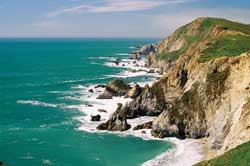Point Reyes
Sep 22, 2009 12:35PM ● By Judy Zimmerman
At Point Reyes National Seashore you can step off the mainland of modern California onto a remote land that nothing has ever seemed to tame.
Thirty miles north of San Francisco on Highway One, this jagged peninsula is a haven of serenity where the wilderness reigns. Its emerald green hills are home to the tule elk, and the rolling grasslands and dense mountain forests reveal endless wonders. In its gentle inland valleys and pastures, you’ll find exotic species, Monterey cypress and blue gum eucalyptus. But nowhere is the impact of Point Reyes more dramatic than at the meeting of land and sea as the thundering surf crashes upon steep cliffs, or where a windswept promontory gives way to broad beaches, peaceful estuaries and placid bays.
This tranquil 100-square-mile landscape sits atop the San Andreas. During the 1906 earthquake in San Francisco, the entire Point Reyes peninsula shook and suddenly moved 16 to 20 feet northwest of the Marin mainland. It still moves north as much as two inches per year, suggesting a larger restlessness as mysterious as the fault that gives it life.
Just off Highway One at Olema, the National Seashore’s Bear Valley Visitor Center is your main source of maps, exhibits and ranger’s advice. Beautiful audio-visual presentations are also available upon request. One could easily spend a full day or two in the Bear Valley area, but to really begin discovering the hidden mysteries and intricacies of Point Reyes, you must leave the visitor center and the roads and explore on foot the grand network of trails.
The Bear Valley Trail from the visitor center continues to be one of the most popular hikes in the park. For 4.1 miles this wide, easy path follows Bear Valley Creek, meandering through the forest of large Douglas fir, bay, and redwood trees and ending at a 50-foot cliff for a wonderful view of the ocean. Summer and early fall are ideal times for strolling along the beach beneath some of the most spectacular seaside cliffs in California. Swimming is permitted only at the more sheltered Drake’s Beach. Here, at the Kenneth C. Patrick Visitor Center, you will also find marine exhibits, a café and showers.
By taking Pierce Point Road from Tomales Bay State Park you can watch the birds, canoe in Abbott’s Lagoon, or explore tidepools at Kehoe and McClure Beaches. Pierce Point Road ends at the tule elk range – where the elk were hunted to the brink of extinction in the mid-1800s, but later restored to their natural habitat. Along the meandering road you may have to stop for a cow to pass from a nearby working ranch.
Whales are most often sighted from January through April when their migration is under way. The observation platform of Point Reyes Lighthouse and the Chimney Rock area are some of the best whale watching spots in the park.
While fall, with its mild, balmy weather, and spring, with its profusion of wildflowers, are good times to explore the peninsula’s enchanted diversity, at Point Reyes the time is always right, in any season.
 Postcard from Point Reyes National Seashore
Postcard from Point Reyes National Seashore
EAT
Station House Café
415-663-1515
stationhousecafe.com
Pine Cone Diner
415-663-1536
Bovine Bakery
415-663-9420
Manka’s – Inverness
415-669-1034
mankas.com
PLAY
Five Brooks Stables
Guided Horseback Riding and Hay Rides
415-663-1570
fivebrooks.com
Marin County Visitors Bureau
866-925-2060
visitmarin.org
Rancho Nicasio
415-662-2219
ranchonicasio.com
STAY
Pt. Reyes Country Inn & Stables
415-663-9696
ptreyescountryinn.com
Pt. Reyes Seashore Lodge & Conference Center
800-404-LODGE
pointreyesseashore.com
10 Inverness Way Bed & Bath
415-669-1648
teninvernessway.com
Olema Ranch Campground
415-663-8001

